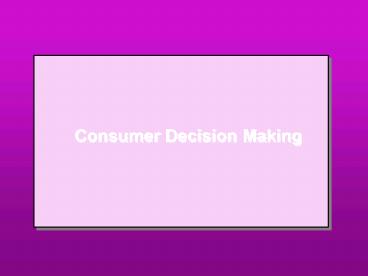Consumer Decision Making - PowerPoint PPT Presentation
1 / 17
Title:
Consumer Decision Making
Description:
Cognitive Dissonance occurs when there is an ... Reduce dissonance by. justifying the purchase. decision ... experience cognitive dissonance. Situation. Social ... – PowerPoint PPT presentation
Number of Views:120
Avg rating:3.0/5.0
Title: Consumer Decision Making
1
Consumer Decision Making
2
Objectives
3
Objectives (cont.)
4
Understanding Consumer Behavior
Consumer Behavior
- Describes how consumers make purchase decisions
- Describes how they use and dispose of
goods/services - Reduces uncertainty when creating the marketing
mix
5
Consumer Decision-Making Process
Cultural, Social, Individual and Psychological
factors affect all steps
6
Need Recognition
Consumers are faced with an imbalance between
present status and preferred state
Stimuli
Internal
External
Preferred State
Present Status
7
Need Recognition
Wants
Preferred State
Back
Present Status
8
Information Search
9
Extent of Information Search
Back
10
Evaluation of Alternatives
Evoked Set
- Evaluation of Products by attributes
- Pick specific product attributes
- Use cutoff criteria
- Rank attributes by importance
Purchase!
Back
11
Purchase
To buy or not to buy...
Marketing
tries to determine which attributes are most
important in influencing a consumers choice
Back
12
Postpurchase Behavior
Cognitive Dissonance occurs when there is
an inconsistency between values and/or opinions
and behavior
- Reduce dissonance by
- justifying the purchase
- decision
- Seek information that reinforces the decision
- Avoid negative information
- Seek contrary information and refute it
Back
13
Types of Consumer Buying Decisions
Routine Response Behavior
Limited Decision Making
Extensive Decision Making
More Involvement
Less Involvement
14
Types of Consumer Buying Decisions
Routine Response Behavior
- Little involvement in selection process
- Frequently purchased low cost goods
- May stick with one brand
- Quick decision
15
Types of Consumer Buying Decisions
Limited Decision Making
- Previous product experience
- Low levels of involvement
- Low to moderate cost goods
- Evaluation of a few alternative brands
- Short to moderate time to decide
16
Types of Consumer Buying Decisions
Extensive Decision Making
- High involvement in selection process
- High cost goods
- Evaluation of many brands
- Long time to decide
- May experience cognitive dissonance
17
Level of Consumer Involvement
Factors Determining Level of Involvement
18
Factors Influencing Buying Decisions
19
Cultural functional, learned, dynamic
Components ofAmerican Culture
20
SubculturesA subculture is a homogeneous group
of people who share elements of the overall
culture as well as cultural elements unique to
their own groupA subculture of consumption
comes into existence as people identify with
certain objects or consumption activities and,
through those activities or objects, identify
with other people
- Attitudes, values and purchase decisions are more
similar than broader culture - Example The bikers study in Journal of Consumer
Research, 1995 - Hierarchies within subculture
- Cycle Lords of the High Truth
- RUBies Rich Urban Bikers
- SEWERS Suburban Weekend Riders
- RIOTS Retired Idiots On Tour
- BASTARDS Bought A Sportster, Therefore A Radical
Dude
21
Social Factors
Social Influences
Reference Groups
Family Members
Opinion Leaders
22
Reference GroupsAll formal and informal groups
that influence buying behavior
23
Reference Groups
- Serve as information sources influence
perceptions - Norms constrain or stimulate purchase behavior
Back
24
Opinion LeadersEarly adopters, typically not
innovatorsHard-core or high-status members of
subcultures function as opinion leaders
- Typically, face to face/word-of-mouth information
- Endorsements
- Celebrity
- Individual professionals
- Group endorsements
- American Heart Association
Back
25
FamilyResponsible for the socialization process
- Initiators
- Influencers
- Decision-Makers
- Purchasers
- Consumers
Purchase Roles in the Family
Children Influence Purchase Decisions
Back
26
Individual Factors
Individual Influences
Gender
Personality Self-Concept Lifestyle
Age Family Life Cycle
27
Individual Factors
Personality a broad concept that can be
thought of as a way of organizing and
grouping how an individual typically
reacts to situations
Self-Concept How consumers perceive
themselves, including attitudes,
perceptions, beliefs and self-evaluations ideal
self-image vs. real self-image
Lifestyle a mode of living identified by
a persons activities, interest, and
opinions useful for segmentation and targeting
28
Psychological Factors
Psychological Influences on Buying Decisions
29
Perception
the process by which an individual selects,
organizes, and interprets information inputs
(stimuli) to create a meaningful picture of the
world.
Selective Distortion Distort information that
conflicts with beliefs
Selective Retention Remember only
informationthat supports feelings and
beliefs
30
Motivation
Maslows Hierarchy of Needs
Self-Actualization
Self- Esteem
Social
Safety
Physiological
back
31
Learning
32
Beliefs and Attitudes
Description
Belief
An organized pattern of knowledge that an
individual holds as true.
Attitude
Learned tendency to respond consistently toward
an object































